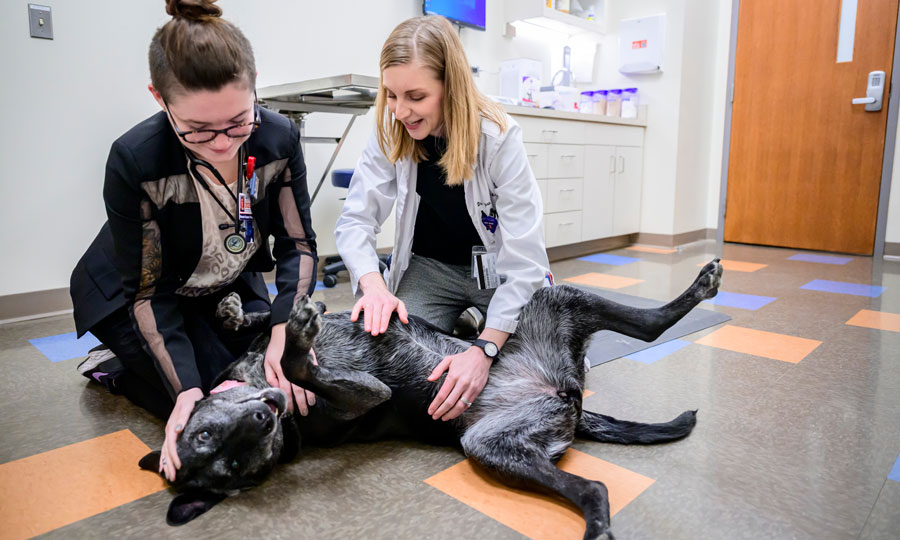Communication between owner and vet is vital
Two acronyms that can be confusing to cat owners are FeLV and FIV. FeLV stands for feline leukemia virus, and FIV is feline immunodeficiency virus. Although caused by distinct viruses, these diseases have similarities: both are contagious and incurable; both are more likely to be acquired by a cat that is allowed outside. Neither virus can be passed to people or species other than cats.
 Dr. Jennifer Reinhart, a veterinarian who is board certified in small animal internal medicine, has treated many patients with these viruses at the University of Illinois Veterinary Teaching Hospital in Urbana. She wants owners to know that their infected cats can live normal lives.
Dr. Jennifer Reinhart, a veterinarian who is board certified in small animal internal medicine, has treated many patients with these viruses at the University of Illinois Veterinary Teaching Hospital in Urbana. She wants owners to know that their infected cats can live normal lives.
FeLV
FeLV is caused by a retrovirus that becomes part of the animal’s DNA. This virus is transmitted when cats are in close contact with each other.
FeLV breaks down a cat’s immune system, leading to symptoms that include pale gums, yellow color of the mouth and whites of the eyes, weight loss, and poor coat condition.
“What can be tricky about FeLV is that the disease can vary greatly between cats,” Dr. Reinhart explains. “It may become dormant and not cause outward health issues in one cat, but may cause illness and even cancer in another.”
Additionally, even if an infected cat does not have outward clinical signs, it still able to pass the virus to other cats.
Unfortunately, there isn’t a cure for FeLV. “We still have hope for some antivirals that are currently used for humans,” Dr. Reinhart says. However, no treatment is currently available for animals.
The prognosis depends heavily on the signs that the animal is exhibiting when presented to the veterinarian. If the animal appears healthy at the time of diagnosis, the prognosis is typically better.
“The best way to prevent the spread of FeLV is to have your cat tested,” Dr. Reinhart says. If the cat tests positive, it should be an indoor-only cat to avoid spreading the virus to other felines in the area and to prevent the cat, whose immune system is compromised, from acquiring other infections. FeLV-positive cats should be an only cat or should live only with other cats that also have FeLV.
FIV
FIV has highly variable clinical signs that are similar to FeLV and include fever, anemia, weight loss, and diarrhea along with a high risk for secondary infections. FIV tends to be clinically less aggressive than FeLV.
“FIV is classically seen as a disease of male aggression from cats biting each other,” Dr. Reinhart explains. It isn’t as closely associated with communal living as FeLV. Cats most often seen with FIV are younger adults to middle age.
FIV has incorrectly been referred to as “cat AIDS.” “This comparison is just not accurate,” says Dr. Reinhart. “Most cats with FIV will not progress to a clinical stage. More likely than not, a cat diagnosed with FIV will go on to live a normal life.”
Diagnosis of FeLV and FIV
Both FeLV and FIV can be diagnosed with a blood test that detects the FIV antibody and FeLV antigen circulating in the blood.
“The blood test, used for both FeLV and FIV, can be performed in the veterinary office and deliver results in about 10 minutes,” Dr. Reinhart explains.
Cats positive for FIV or FeLV should be housed indoors and continue to have regular veterinary examinations and health care. Reducing stress in their environment, encouraging eating, and providing fresh water will help keep them healthy.
Normal Life Possible
Dr. Reinhart emphasizes that a positive diagnosis for FeLV and/or FIV is not an automatic death sentence for cats. Although cats can die from these diseases, many live several years after diagnosis or even have a normal lifespan.
“It can be scary for pet parents to hear that their cat has an incurable disease,” Dr. Reinhart says “However, with regular veterinary visits, it is possible for the cat to have a normal, happy life at home.”
Ongoing communication between the pet owner and veterinarian is vital to help the cat live a healthy life.
If you have questions about FIV or FeLV, contact your local veterinarian.
By Beth Mueller

![[black cat in a kitchen]](https://vetmed.illinois.edu/wp-content/uploads/2021/04/pc-reinhart-fiv-felv.jpg)


